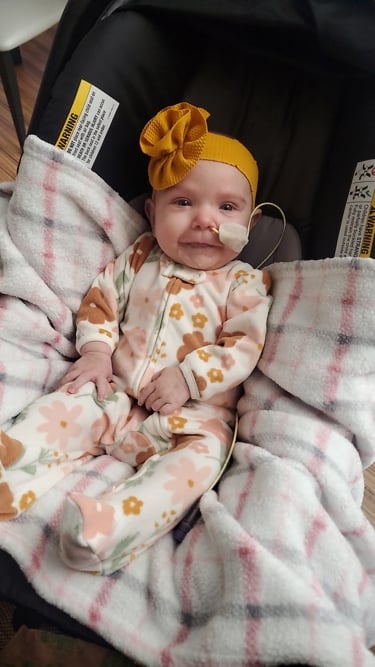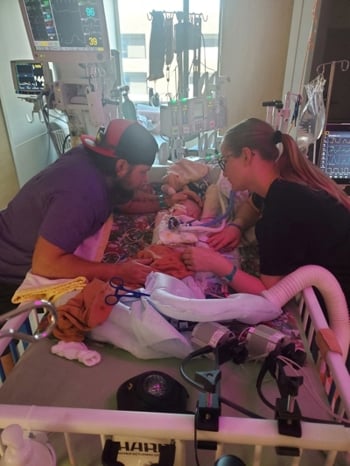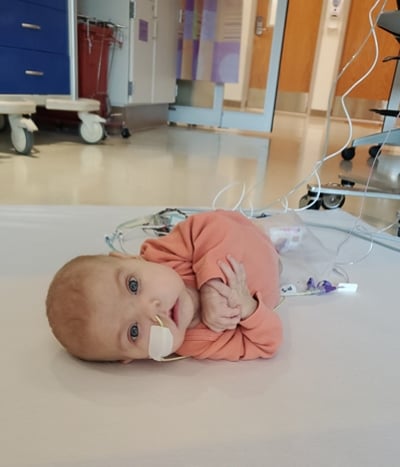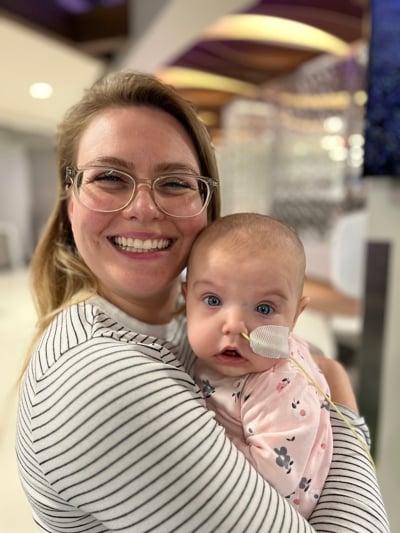Wrenley’s Story
CM celebrates its 50th heart transplant

Late on August 8, Edo Bedzra, MD, MBA, congenital cardiac surgeon; William Gibson, DO, Surgical Director, Cardiac Transplantation; and James O’Brien, MD, FACS, Co-Director of the Ward Family Heart Center and Chief of Cardiothoracic Surgery left the operating room. Someone said congrats: They had just completed the 50th heart transplant at Children’s Mercy Kansas City.
Only three months later, their patient, Wrenley, is thriving with her new heart. The nine-month-old is teething, growing and infinitely curious about the world around her.
It’s time to celebrate.
“She’s such a little fighter,” said Wrenley’s mom, Jordin Stephens, a nurse who has worked in labor and delivery and GI at another hospital . “Any task or goal we give her, she’s just like, ‘Yeah, sure, let me surpass that.’”
Wrenley’s tenacity matches the heart transplant team’s. Since their first transplant in 2015, the program has become one of the nation’s best, with a 100% 1-year patient survival rate post-transplant and the third best overall survival rate from listing.
“The growth in both the number of transplants we do in a year and how complex they are has been dramatic,” said Dr. O’Brien.
“We’re not a new program anymore,” said Dr. Gibson. “We’re an experienced program. We don’t send away complex heart transplant cases; we can take care of them here.”
Big milestone; complex case
Wrenley’s story is a testament to that evolution. At 3 months, Wrenley began having trouble gaining weight. Jordin and Wrenley’s dad, Nate, brought her to Children’s Mercy, where she was diagnosed with hypertrophic cardiomyopathy, a thickening of the heart muscle usually seen in older children or adults. After meeting with the Heart Failure team, Wrenley and her family went home with new meds, a care plan...and no idea a respiratory virus was about to turn their lives upside down.
By the next afternoon, Wrenley was struggling to breathe. After a very scary EMS ride and an unplanned stop at another hospital where Children’s Mercy cardiologists helped stabilize Wrenley over the phone, they were back at the Heart Center. Wrenley was put on Extracorporeal Membrane Oxygenation (ECMO) just after midnight on May 18. The team began the transplant evaluation process.
“With her severity of hypertrophic cardiomyopathy, there’s not a whole lot you can do to relieve that obstruction,” said Dr. Gibson. Wrenley joined the transplant list on June 1 at the highest urgency level.
Creative, collaborative solutions
“The whole goal of support is to have her as healthy as possible going into transplant,” explained Brian Birnbaum, MD, FACC, FAAP, Heart Center physician. “She was incredibly sick, and the entire hospital did everything we could.”

“There was a lot of creative thinking among a multidisciplinary team,” said Aliessa Barnes, MD, Co-Director of the Ward Family Heart Center and Chief of Pediatric Cardiology. An unusual use of a ventricular assist device (VAD) was one example.
“The pump goes directly into the pumping chamber, but her heart was so thick it wouldn’t fit there,” said David Sutcliffe, MD, Director of Heart Transplant and Ventricular Assist Device. “It had to go into the top chambers of the heart, which is not necessarily traditional.”
Transitioning to the VAD gave Wrenley’s family the much-needed opportunity to hold her, but she continued to have respiratory issues.
“I can’t tell you how many days Jordin and I sat there trying to figure out why?” said Kathryn Slagle, RN, BSN, one of Wrenley’s primary CICU nurses. “She has a breathing tube. Both sides of her heart are supported. Why are we struggling?”
Wrenley’s heart had gotten so big it was compressing the veins in her lungs, so the team made the decision to go back to ECMO support on July 21. “The team was able to connect the ECMO circuit to her VAD cannulas, with some careful considerations of anatomy and cannulae location,” explained Kari Davidson, MSN, RN, CCRN, Director of Extracorporeal Support. One more creative solution; one more chance to get Wrenley to transplant.
Difficult decisions
When transplant candidates are very sick, the care team and family face a tough question: “Have we passed a point of no return, or can we proceed forward?” said Dr. Sutcliffe.
“We need to make sure that if we replace the heart, all the other organs are in good enough shape that they can help the person recover,” Dr. Gibson explained. It was challenging, but the team ultimately determined that if Wrenley had a healthy heart, her lungs would follow.
“There were a lot of times where we were very concerned that her ability to be supported effectively was at risk,” said Dr. Sutcliffe. “We benefited from the knowledge, experience and expertise of all the folks on the team [during] a really complex and challenging situation.”
Compounded miracles
That collaborative effort ensured that when the call came, Wrenley and the team were ready to go.
“Your first thought when you see the Children’s Mercy number is ‘What’s wrong?’ Especially at two o’clock in the morning,” said Jordin, remembering that early August 8 phone call. “The first thing they said was, ‘She’s okay. Don’t worry. But we have the perfect heart.’”
“It was an overwhelming miracle that we got a heart for her,” said William Douglas, MD, cardiothoracic surgeon, Heart Center. “Wrenley’s time waiting for a heart was very difficult, and there was a time I thought it was unlikely that she would survive to get a transplant. And then, all of a sudden, the heart emerged.”
“Her miracle wasn’t just the transplant,” echoed Dr. O’Brien. “Her miracle was everything that happened getting her to the transplant as well as having the family there, all the support in the ICU, the creative mechanical assist device she was put on — without that, there was no way she was going to get to the transplant.”
The team was determined to honor the grieving family on the other side of that all-important phone call. “The transplant does not work without the incredible generosity of the family who’s going through a tragic experience,” added Dr. O’Brien.
Wrenley’s big day

“We got there first thing in the morning, and a lot of happy tears were shed,” said Jordin. They got to spend the morning with Kathryn, who had picked up a shift at the last minute without knowing it was going to be Wrenley’s biggest day yet.
Dr. Douglas went to transport the heart while the rest of the team began getting Wrenley ready for surgery. “Being on the assist device makes it a little more complex, and then hers was a unique arrangement,” said Dr. O’Brien. “We really picked one of the more challenging transplants to do for our 50th!”
With constant communication, the team had Wrenley ready right when Dr. Douglas arrived with the heart. They kept Jordin, Nate and Jordin’s mom, Sheri, updated via the EASE app throughout the 11-hour procedure.
“This is the miracle of transplant, as I’ve always thought of it: The heart that’s been outside of the body for three to four hours, you give it some blood, and it starts beating,” said Dr. Bedzra.
Wrenley’s new heart started beating strong, right on time.
A surprising recovery
During the first few days post-transplant, Jordin and Kathryn marveled over how warm Wrenley was, now that her body was circulating blood on its own. “We thought she had a fever because we were so used to her being cold all the time,” said Jordin.
Wrenley spent a little over a month recovering in the CICU. About a week after her transplant, it was time to see if she could breathe on her own.
“It was nerve-wracking because we had failed extubation so many times before,” said Jordin. Wrenley had been on respiratory support the entire time she was at Children’s Mercy. But with her new heart, it was different: “She was like, ‘I can breathe! I don’t need high-flow oxygen! I don’t need any of this!’ It was amazing,” said Jordin.
After moving to the regular cardiac floor, Wrenley was discharged on September 20 and had a party to remember.
“She was out of the hospital in half the time I would have anticipated,” said Dr. Gibson.
“There’s a direct correlation to all the work that was put in day in, day out in the CICU before her
transplant and now,” said Katie Garner, RN, BSN, Solid Organ Transplant Coordinator, Heart Center. The team credits Wrenley’s family in those kudos.
“Jordin’s perseverance and optimism in the face of so many setbacks were amazing to watch,” said Kathryn.
“Jordin brings all of her expertise, but all of the humility in the world,” said Dr. Sutcliffe. “She asks great questions but has confidence and trust in the team.”
Jordin returns that respect, saying that the CICU nurses checked in regularly to make sure her “nurse brain” wasn’t taking over her “mom brain” and commended the collaboration and respect the Children’s Mercy team displayed.
“I was really blown away by how good of a team they are,” said Jordin. “They take everything to heart. If a nurse brought up a concern in rounds, they took time to hear everybody. That’s not normal. It was really awesome to see.”
New heart, new normal

Wrenley now has weekly checkups and therapy and is doing “fantastically well,” said Dr. Sutcliffe. Jordin reports they are savoring watching
Wrenley grow and hit new milestones — with a whole village cheering her on from Children’s Mercy.
“She’ll be crawling before we know it,” said Jordin . “Sometimes I just have to step back and think: We’re getting to do normal baby things, and that’s awesome!”
“It was an exercise in perseverance,” said Dr. Douglas. “There were many times when it would have been very reasonable to just stop. When you look at Wrenley, you look at why it is that we persist in a lot of high-risk situations. Because sometimes you win. And Wrenley’s a win.”
Hard-won successes like Wrenley’s will propel the team through the next 50 heart transplants.
“I still pinch myself that I get to do this,” said Katie. “50 is a big deal for our program. We’re very proud of where we’ve come from and will continue to grow and expand.”
